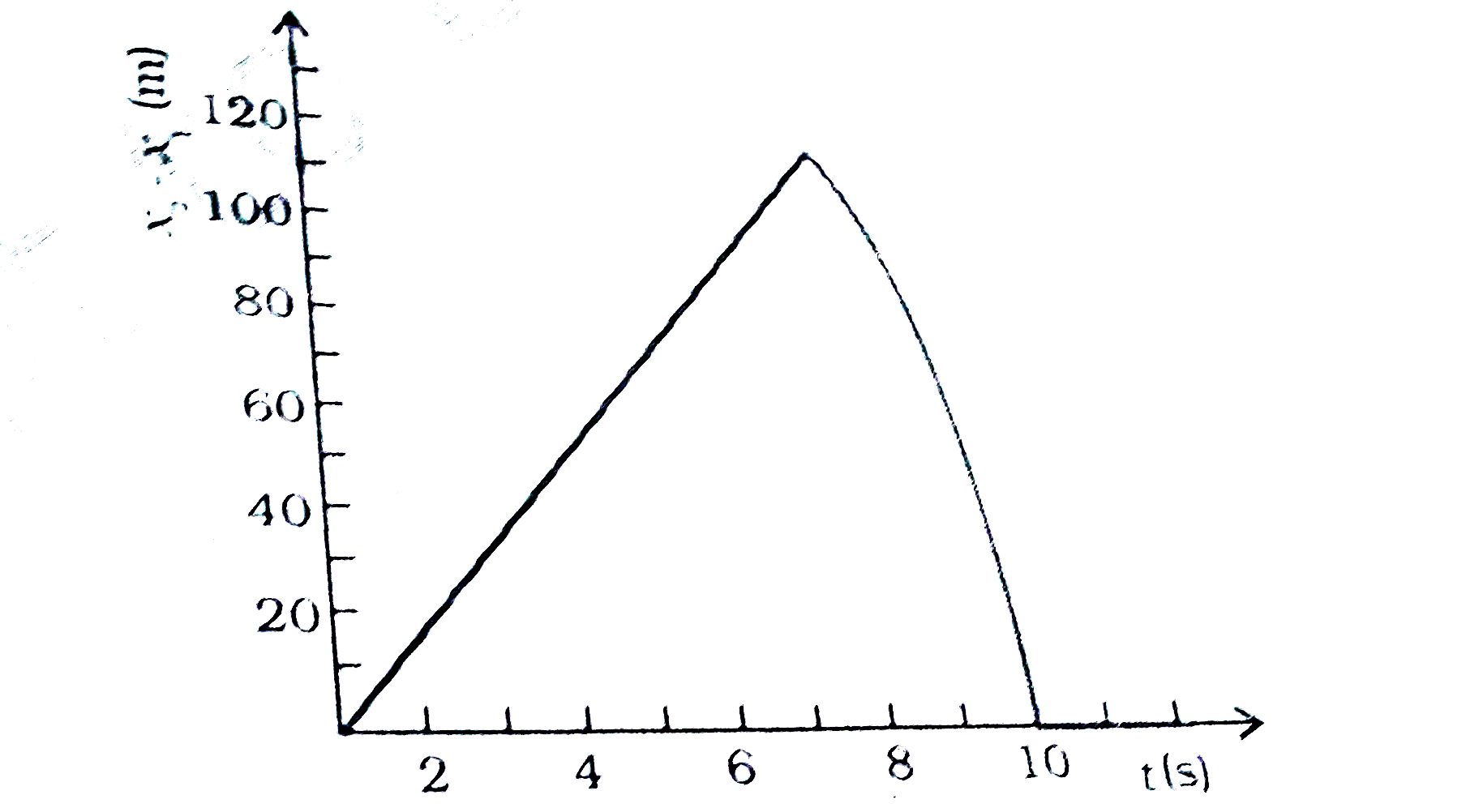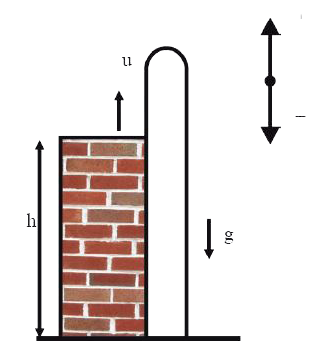Two stones are thrown up simultaneously from the edge of a cliff 240 m high with initial speeds of 10 m/s and 40 m/s respectively. Which of the following graphs best represents the time variation of relative position of the second stone with respect to the first?
(Assume stones do not rebound after hitting the ground and neglect air resistance take g = 10 m/s2 ) The figures are schematic and not drawn to scale)




The correct Answer is:C
We consider the upward direction to be positive.
∴Y=ut−12gt2
Till they reach the ground for the first stone,
−240=10t−12×10t2
or, 5t2−10t−240=0 or,5(t+6)(t−8)=0
∴ t = 12s
So, for the last (12-8=) 4s, only the second stone will be in motion. Hence in the time span between 8 s and 12s
y2−y1=(40t−5t2)−0=40t−5t2
which is the equation of a parabola.
Now in the time span between 0 s to 8 s , y2−y1=(40t−5t2)−(10t−5t2)=30t
which is the equation of a straight line passing through the origin.
Topper's Solved these Questions
- ONE - DIMENSIONAL MOTION BOOK - CHHAYA PUBLICATIONCHAPTER - ONE - DIMENSIONAL MOTION EXERCISE - EXAMINATION ARCHIVE with solutions (AIPMT )
1 Video
- ONE - DIMENSIONAL MOTION BOOK - CHHAYA PUBLICATIONCHAPTER - ONE - DIMENSIONAL MOTION EXERCISE - EXAMINATION ARCHIVE with solutions ( NEET)
1 Video
- ONE - DIMENSIONAL MOTION BOOK - CHHAYA PUBLICATIONCHAPTER - ONE - DIMENSIONAL MOTION EXERCISE - EXAMINATION ARCHIVE with solutions (WBJEE )
4 Videos
- NEWTONIAN GRAVITATION AND PLANETARY MOTIONBOOK - CHHAYA PUBLICATIONCHAPTER - NEWTONIAN GRAVITATION AND PLANETARY MOTIONEXERCISE - CBSE SCANNER
19 Videos
- QUESTION PAPERS OF NEET -2017BOOK - CHHAYA PUBLICATIONCHAPTER - QUESTION PAPERS OF NEET -2017EXERCISE - QUESTION
32 Videos
Similar Questions
A particle of unit mass undergoes one-dimensional motion such that its velocity varies according to v (x) = βx−2n , where β and n are constants and x is the position of the particle. The acceleration of the particle as a function of x is given by
View SolutionIf the velocity of a particle is v = At+Bt2, where A and B are constant then the distance travelled by it between 1 s and 2 s is -
(A) (3A+7B)
(B) 32A+73B
(C) A2+B3
(D) 32A+4B
View SolutionA particle moves with constant acceleration along a straight line starting from rest. The percentage increase in its displacement during the 4th second compared to that in the 3rd second is
View SolutionWhat is the reason for absence of atmosphere in some planets?
View SolutionA molecule of a substance has permanent dipole moment p . A mole of this substance is polarised by applying a storg electrostatic field E . The direction of the field is suddenly changed of 60∘ . If N is the avogadro's number the amount of work done by the field is
View SolutionTwo stones are thrown up simultaneously from the edge of a cliff 240 m high with initial speed of 10 m//s and 40 m//s respectively . Which of the following graph best represents the time variation of relative position of the speed stone with respect to the first ? ( Assume stones do not rebound after hitting the groumd and neglect air resistance , take g = 10 m//s^(2)) ( The figure are schematic and not drawn to scale )
View SolutionTwo stones are thrown up simultaneously from the edge of a cliff 200 m high with initial speeds of 15 m s^(-1) and 30 m s^(-1) respectively. The time variation of the relative position of the second stone will request to the first as shown in the figure. The equation of the linear part is
View Solutionकिसी 200 m ऊंची खड़ी चट्टान के किनारे से दो पत्थरों को एक साथ ऊपर की ओर 15ms−1 तथा 30ms−1 की प्रारंभिक चाल से फेंका जाता है | इसका सत्यापन कीजिए कि नीचे दिखाया गया ग्राफ (चित्र 3.27) पहले पत्थर के सापेक्ष दूसरे पत्थर की आपेक्षिक स्थिति का समय के साथ परिवर्तन को प्रदर्शित करता है | वायु के प्रतिरोध को नगण्य मानिए और यह मानीय की जमीन से टकराने के बाद पत्थर ऊपर की ओर उछलते नहीं | मान लीजिए g=10ms−2 | ग्राफ के रेखीय व वक्रीय भागों के लिए समीकरण लिखिए |

View Solutionकिसी 240 मी ऊँची चोटी से एक किनारे से, दो पत्थरों को एक साथ ऊपर की और फेंका गया है ,इनकी प्रारम्भिक चाल क्रमश : 10मी/से तथा 40 मी/से है, तो निम्नांकित में से कौन-सा ग्राफ (आलेख) पहले पत्थर के सापेक्ष दूसरे पत्थर की स्थिति के समय विचरण (परिवर्तन) को सर्वाधिक सही दर्शाता है ?
मान लीजिए कि,पत्थर जमीन से टकराने के पश्चात् ऊपर की ओर नहीं उछलते हैं तथा वायु का प्रतिरोध नगण्य है, दिया है g=10मी/से2| (यहाँ ग्राफ केवल व्यवस्था आरेख हैं ओर स्केल के अनुसार नहीं हैं )
View SolutionTwo stones are through up simultaneously from the edge of a cliff 240 m high with initial speed of 10 m/s and 40 m/s respectively. Which of the following graphs best represents the time variation of relative position of the second stone with respect to the first? Assume stones do not rebound after hitting the ground and neglect air resistance, take . g=10m/s2 (The figures are schematic and not drawn to scale)
View SolutionTwo stones are through up simultaneously from the edge of a cliff 240 m high with initial speed of 10 m/s and 40 m/s respectively. Which of the following graphs best represents the time variation of relative position of the second stone with respect to the first? Assume stones do not rebound after hitting the ground and neglect air resistance, take . g= 10 m//s^(2) (The figures are schematic and not drawn to scale)
View SolutionTwo stones are thrown up simultaneously from the edge of a cliff 240 m high with initial speed of 10 m/s and 40 m/s respectively. Which of the following graph best represents the time variation of relative position of the second stone with respect to the first ?
(Assume stones do not rebound after hitting the ground and neglect air resistance, take g = 10 m/s2 ). (The figures are schematic and not drawn to scale)
View SolutionTwo stones are thrown up simultaneously from the edge of a cliff 200 m high with initial speeds of 15 ms^(-1) and 30 ms^(-1) . Verify that the graph shown in Fig. correctly represents the time variation of the relative position of the second stone with respect to the first. Neglect air resistance and assume that the stones do not rebound after hitting the ground. Take g = 10 ms^(-2) . Give the equations for the linear and curved parts of the plot.
View SolutionTwo stones are thrown up simultaneously from the edge of a cliff 200 m high with initial speeds of 15 ms^(-1) and 30 ms^(-1) . Verify that the graph shown in Fig. correctly represents the time variation of the relative position of the second stone with respect to the first. Neglect air resistance and assume that the stones do not rebound after hitting the ground. Take g = 10 ms^(-2) . Give the equations for the linear and curved parts of the plot.
View SolutionA stone is thrown vertically up from the tower of height 25m with a speed of 20 m/s What time does it take to reach the ground ? (g=10m/s2)

View Solution

